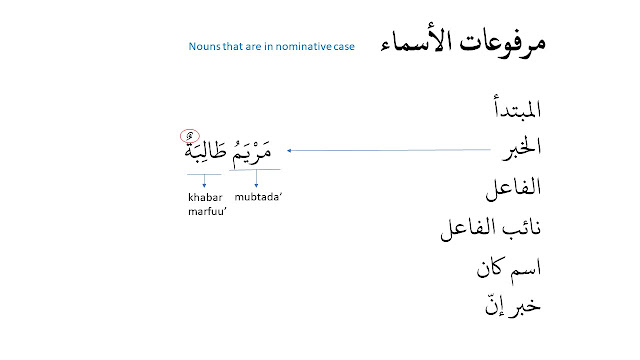Mastering the Nominative Case in Arabic | حالة الرّفع or مرفوع
Today, I will introduce you to one of the most important topics in Arabic grammar: noun cases.
Noun cases are the different forms that nouns take depending on their function and position in a sentence.
There are three main noun cases in Arabic: nominative, accusative, and genitive.
In this lesson, we will focus on the nominative case (حالة الرّفع or مرفوع), which is used for the subject and predicate of a nominal sentence (جملة اسميّة), a doer (فاعل) of a verbal sentence (جملة فعليّة), etc.
I will explain what nominative case is, when do you use it, the sign or indication of nominative case, and how to recognize it.
I will also give you some examples of sentences and their translations.
By the end of this lesson, you will be able to identify and use nominative nouns in Arabic with confidence. Let’s get started!
أقسام الإعراب (Types of I'rab of Types of declension)
There are four types of i'rab, they are:
1. الرفع (ar-raf'), raf' condition is called marfuu' (مرفوع) or nominative case.
2. النصب (an-nasb), nasb condition is called mansuub (منصوب) or accusative case.
3. الجر (al-jar), jar condition is called majruur (مجرور) or genitive case.
4. الجزم (al-jazm), jazm condition is called majzuum (مجزوم) or jussive case.
The declension of noun are three, they are: marfuu', mansuub, and majruur.
In this lesson, we'll focus on haalatur raf' or marfuu' or nominative case.
What is nominative (الرفع)?
اَلرَّفْع : تَغْيِيرٌ مَخْصُوصٌ وَعَلَامَتُهُ اَلضَّمَّةُ وَمَا نَابْ عَنْهَا
ar-raf': a particular change that is indicated by a dhammah and anything that represents a dhammah.
When is a noun in a raf' condition/marfuu'/nominative case?
As I mention earlier: "Noun cases are the different forms that nouns take depending on their function or position in a sentence. "
Below is the function of a noun that makes the noun in the marfuu' condition:
1. Nouns that are functioning as mubtada (مبتدأ).
2. Nouns that are functioning as khabar (خبر).
I recommend you to review or re-study jumlah ismiyyah and mubtada' and khabar concept and examples
3. Nouns that are functioning as doer or fa'il (فاعل).
4. Nouns that are functioning as a substitution of doer or na-ibul fa'il (نائب الفاعل).
note: In terms of concept, fa'il and na-ibul fa'il have the same concept, so I'm only giving examples of fa'il.
5. Nouns that are functioning as ism kaana (اسم كان).
We'll study ism of kaana and it's sister in the future, in shaa Allah.
6. Nouns that are functioning as khabar inna (خبر إنّ).
We'll study ism of inna and it's sister in the future, in shaa Allah.
Sentence Examples
1. Jumlah ismiyyah (جملة اسميّة)
- البَيْتُ كِبِيْرٌ (al-baytu kabiirun).
The meaning: The house is big.
-- البَيْتُ is mubtada' => it is in raf' condition or marfuu' (مرفوع)/nominative case.
The sign/indication of the raf' is dhammah "u".
-- كِبِيْرٌ is khabar => it is in raf' condition or marfuu' (nominative case).
The indication of it's raf' is dhammah "u".
- مَرْيَمُ طَالِبَةٌ (Maryam taalibatun).
The meaning: Maryam is a student.
-- مَرْيَمُ is mubtada' marfuu' (مبتدأ مرفوع), the indication of the raf' is dhammah "u"
-- طَالِبَةٌ is khabar marfuu' (خبر مرفوع), the indication of the raf' is dhammah "u"
- الطَّبِيْبُ طَيِّبٌ (at-tabiibu tayyibun).
The meaning: The doctor is good.
-- الطَّبِيْبُ is mubtada' marfuu', the indication of the raf' is dhammah "u".
-- طَيِّبٌ is khabar marfuu', the indication of the raf' is dhammah "u".
2. Jumlah fi'liyyah (جملة فعليّة)
- ذَهَبَ الوَلَدُ (dhahaba al-waladu).
The meaning: The boy went.
-- ذَهَبَ is fi'l madi (فعل الماضي).
-- الوَلَدُ is fa'il (فاعل), it is marfuu' (مرفوع), the indication of the rafa' (علامة الرّفع) is dhammah "u".
- تَنامُ الْبِنْتُ فِي الْبَيْتِ (tanaamu al-bintu fii al-bayti).
The meaning: The girl sleeps in the house.
-- تَنامُ is fi'l mudari' (فعل المضارع).
-- الْبِنْتُ is fa'il marfuu' (فاعل مرفوع), the indication of the raf' is dhammah "u".
-- فِي is harf jar (حرف جر).
-- الْبَيْتِ is ism majruur because it is preceded by harf jar 'في', the indication of the jar is kasrah "i".

3. ism kaana (اسم كان)
- كَانَ الطَّالِبُ نَشِيْطًا (kaana at-taalibu nashiitun).
The meaning: The student was energetic.
-- كَانَ is annuler verb.
-- الطَّالِبُ is ism kaana marfuu', the indication of the rafa' is dhammah "u".
-- نَشِيْطًا is khabar kaana mansuub, the indication of the nasb is fat-hah "a".
- كَانَ الوَلَدُ مَرِيْضًا (kaana al-waladu mariidan).
The meaning: The boy was sick.
-- كَانَ is annuler verb.
-- الوَلَدُ is ism kaana marfuu', the indication of the raf' is dhammah "u".
-- مَرِيْضًا is khabar kaana mansuub, the indication of the nasb is fat-hah "a"
4. khabar inna (خبر إنّ)
- إِنَّ البَيْتَ كَبِيْرٌ (inna al-bayta kabiirun).
The meaning: Indeed, the house is big.
-- إِنَّ: harf lita'kiid (حرف للتأْكيد) or particle of emphasis.
-- البَيْتَ: ism inna mansuub, the indication of the nasb is fat-hah "a".
-- كَبِيْرٌ: khabar inna marfuu', the indication of the raf' is dhammah "u".
- إِنَّ الطَّالِبَ حَاضِرٌ (inna at-taaliba haadirun).
The meaning: Indeed, the student is present.
-- إِنَّ: harf lita'kiid (حرف للتأْكيد) or particle of emphasis.
-- الطَّالِبَ: ism inna mansuub, the indication of the nasb is fat-hah "a".
-- حَاضِرٌ: khabar inna marfuu', the indication of the raf' is dhammah "u".
Summary
You've studied the noun cases in Arabic (which determine the forms nouns take based on their function/position in a sentence), they are: nominative case (مرفوع), accusative case (منصوب), genitive case (مجرور).
You've comprehended the nominative case (حالة الرّفع), also known as marfuu' (مرفوع).
You've already known that a noun is in nominative case when the noun is functioning as: mubtada', khabar, fa'il, na-ib al-fa'il, ism kaana, and khabar inna.
You've understood that the sign or indication when a noun is in nominative case is dhammah "u".
Next lesson
I believe that you still remember this rule "اَلرَّفْع : تَغْيِيرٌ مَخْصُوصٌ وَعَلَامَتُهُ اَلضَّمَّةُ وَمَا نَابْ عَنْهَا
ar-raf': a particular change that is indicated by a dhammah and anything that represents a dhammah."
I've explained you the main indication of the raf' (it is dhammah "u").
But, there will be another indication that we have to learned, namely "anything that represent a dhammah".
There are two indications of the raf', they are main indication (أصلية) and subsidiary indication (فرعية).
You've learned main indication (it is dhammah "u"), in the next lesson we'll study 'alaamah far'iyyah or subsidiary indication.
So, wait for the next lesson in this blog.
Update: This is the next lesson, study now "the complete indication of a Noun in nominative case"








No comments:
Post a Comment